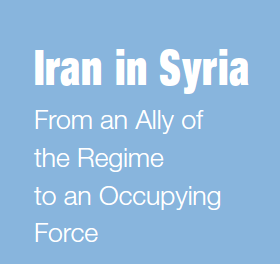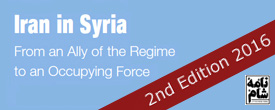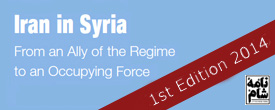Introduction to 2nd Edition
A lot has changed in Syria and the wider region since the first edition of this report was published in November 2014. But a lot has also remained unchanged.
Major developments over the past months include the expansion of Daesh (the so-called Islamic State) in Iraq and Syria; signing a comprehensive nuclear deal with Iran in July 2015; the Iranian-backed coup by the Houthi militias in Yemen and the subsequent military campaign led by Saudi Arabia against them; and the Russian military intervention in Syria.
Yet none of these developments seem to have prompted the US administration and its allies to change their strategy towards Iran – and now toward Russia – in Syria. This report describes it as a policy of slowly bleeding Iran and Hezbollah in Syria at the expense of continued bloodshed in the country and rising extremism and instability in the region.
This second edition provides detailed updates on some of the key issues raised in the first edition:
– A new section on restructuring the notorious Syrian militia known as the National Defence Forces (NDF) provides an overview of reports about Iranian plans to merge and restructure pro-Assad militias, both local and foreign, and turn them more disciplined and more loyal ones. The motivation behind this move appears to be an attempt by the Iranian regime to control these militias that have partly gone out of control and become mafia-style gangs riddled with crime and corruption. Particular attention is paid to efforts to form ‘Hezbollah Syria’, sometimes also called the National Ideological Resistance, which would be similar to Hezbollah Lebanon: a parallel army that is intended to safeguard the Iranian regime’s interests in Syria even after fall of the Assad regime.
– An update on Hezbollah Lebanon’s involvement in Syria details how the group’s role in the war has grown in significance and scale at the expense of Syrian regime forces. The section particularly focuses on key strategic battles in the Qalamon region, along the Lebanese border, and in the south, near the borders with Israel and Jordan. It examines Sepah Pasdaran’s and Hezbollah’s efforts to establish a foothold in southern Syria, which could gradually grow into another front with Israel that would serve as a deterrent against any possible attacks on Iran’s military nuclear facilities, much like the Hezbollah stronghold in southern Lebanon was established in 1980s. The section describes these strategic areas as ‘useful Syria’ and argues that the Iranian military strategy in Syria revolves around defending and securing these areas in order to serve the Iranian regime’s interests in a post-Assad Syria.
– A subsection about Hezbollah’s recruitment efforts in Lebanon provides previously unknown details about the formation, arming and training of various pro-Iranian non-Shia militias in Lebanon with the help of Hezbollah. The section argues that all these sub-militias, which are described among Hezbollah circles as a “reserve pool”, are being prepared to secure the group’s ‘home front’ in Lebanon in the event of escalation there. Some of them could also be deployed to Syria in the future if Hezbollah and other Iranian-controlled militias fighting there become ‘overstretched’.
– An update on Iraqi Shia militias’ involvement in Syria examines the increasing geographical distribution and the more prominent role played by these militias in key battles. Among other things, this has meant that these Iraqi militias can no longer justify and recruit for their fight in Syria solely on the basis of defending holy Shia shrines. Fighting Daesh in Syria as a motive is increasingly found in their literature offline and online. Meanwhile in Iraq, under the pretext of fighting Daesh, Iranian-controlled Shia militias have expanded and consolidated their influence throughout the country to such an extent that they have practically replaced the army and security forces in many areas. Dozens of them recently united, under the auspice of Haider al-Abadi’s government, under the name The Popular Mobilisation Forces. Details of the ways in which these militias cooperate with Baghdad and Tehran, and the role that Iranian ‘advisers’ play, both inside these groups and on the frontlines, are also provided.
– An update on Afghan Shia fighters’ involvement in Syria traces how their number and role in Syria has become more prominent and more open, thanks to concerted propaganda and recruitment efforts by the Iranian regime and its media outlets. The section provides new details of the origins and development of the Fatemiyoun Brigade, and new details about Iranian recruitment efforts among Afghan refugees and migrants in Iran. It also provides an overview of Afghan casualties in Syria and the official funerals held for them in Iran. It then sheds light on new legislative reforms in Iran allowing Afghan and other non-Iranian fighters fighting in Syria to apply for permanent residency permits and Iranian citizenship, which is being used by Sepah Pasdaran as a recruitment incentive besides monthly salaries.
– A new section on Pakistani Shia fighters in Syria provides an overview of their numbers and role in the war. It also provides an overview of Pakistani casualties in Syria and the official funerals held for them in Iran. The formation of the Zaynabiyoun Brigade suggests that the number of Pakistani fighters deployed to Syria is increasing and may increase even further in the future. The section warns that the Shia community in Pakistan is larger than in Afghanistan, and most of the Pakistani Shia live in border areas, making their potential recruitment by Sepah Pasdaran easier.
– An update on the relationship between Daesh and the Syrian and Iranian regimes provides an overview of new reports and evidence that both regimes have infiltrated, collaborated and used Daesh and al-Qaeda-affiliated groups to serve their own interests. This includes releasing Islamist extremists from prison in both countries, facilitating the movement of foreign fighters into Syria, secret oil and arms deals, and a consistent strategy of targeting moderate rebels while largely ignoring Daesh. The section also criticises the Obama administration for overlooking Iran’s relationship with al-Qaeda and its de facto partnership with the Iranian regime and Iranian-controlled militias in Iraq in the battle against Daesh, despite various official reports recommending that this relationship should be investigated.
– An update on Iranian fighters in Syria provides estimates of Iranian Sepah Qods and Basij members killed in Syria and reported by Iranian media as such. Their ranks and the timing and places of their death clearly indicate that Sepah Pasdaran commanders are not only acting as ‘advisors’ to Syrian regime forces, as the Iranian regime claims, but that they are actively leading and fighting battles on various fronts in Syria. The section also provides details of the arrival of hundreds of new Iranian fighters in Syria at the end of 2015 to take part in a major Iranian-led ground offensive, backed by Russian air strikes, in the northern parts of the country.
– A new case study on the death of Iranian Brigadier-General Hossein Hamedani, who was killed near the Syrian city of Aleppo on 8 October 2015, provides details and admissions about his role in Syria, particularly in setting up the notorious National Defence Forces, also known as the shabbiha.
– As with Iranian fighters, an update on Iranian weapons provides an overview of new evidence of Iranian-made weapons being used in Syria, despite international sanctions on Iran and Syria and despite losing control over all of Syria’s border crossings to the Free Syrian Army or to Daesh. The section also provides details of new types of Iranian weapons being used in the ongoing war as a result of the changing nature of the battles. These include Iranian Sukhoi-22 fighter-bombers, which have been at the forefront of the aerial bombardment campaigns against rebel and civilian areas across Syria. New details about Iranian connections to the manufacturing and use of barrel bombs and chemical weapons in Syria are also provided.
– An update on the role of Iranian general Qassem Soleimani, the commander-in-chief of Sepah Qods and the de facto ruler of Syria, provides an overview of his recent activities and appearances in Syria, which have become less secretive as the Iranian propaganda machine attempts to create a legend or a hero that embodies the Iranian regime and its fight against its many enemies in the region. The section also reveals that Jihad Moghniyeh, the Lebanese Hezbollah operative who was killed in an Israeli strike in southern Syria in January 2015, was Qassem Soleimani’s nephew, and that Soleimani was accompanying his father, Imad Moghniyeh, Hezbollah’s former chief of international operations, when this was reportedly assassinated by Israel in Damascus in 2008. The American and Israeli operatives “had a chance” to kill Soleimani too but did not do so as they did not apparently have the authorisation to kill him.
– An update on the economic costs of the war in Syria to Iran and Hezbollah provides new, up-to-date figures and details of how much the war in Syria is costing Iran and the impact this is having on the Iranian economy, ordinary Iranians and Hezbollah. However, the section argues that financial difficulties are unlikely to significantly affect Sepah Pasdaran’s and Hezbollah’s military operations in Syria in the short term, and that it is unlikely that the Iranian regime will reduce its economic and military support to the Syrian regime for reasons to do solely with economic hardship.
– Similarly, an update on the human costs of the war in Syria to Iran and Hezbollah provides an overview of recent Iranian and Hezbollah casualties, which have been mounting in recent months due to a significant increase in the numbers of Sepah Pasdaran and Hezbollah fighters deployed to Syria over the past year, and to the more prominent role they have been playing in keys battles there. The section is supplemented with appendices at the end of the report listing the names of hundreds of Iranian, Hezbollah, Afghan and Pakistani Shia fighters killed in Syria documented by Naame Shaam. The section also provides an overview of Hezbollah’s intensified recruitment efforts among Shia and non-Shia communities in Lebanon, and the new rhetoric it has been using to recruit ever-younger fighters, to make up for its growing losses in Syria. A new case study examines in detail the exceptionally high number of Iranian high-ranking commanders killed in Aleppo in October and November 2015.
– An update on the US policy on Iran and Syria provides an overview of recent developments and statements by US officials, including President Obama, and concludes that, despite major developments, little has changed in the US administration’s strategy on Syria, which this report describes as a policy of slowly bleeding Iran and Hezbollah in Syria at the expense of continued bloodshed in the country and rising extremism and instability in the region.
– Finally, a new section on the Russian military intervention in Syria discusses its motivations, aims and possible outcomes. It shows that it was Qassem Soleimani who dragged Putin into the Syrian quagmire, not Bashar al-Assad, as many commentators claimed at the time. The section examines claims of disagreements and divergence between Moscow’s and Tehran’s stance on al-Assad and argues that the Russian intervention has in fact consolidated the Iranian regime’s control in Syria, rather than countering it. The section also provides an overview of the human and financial costs to Moscow, and concludes that Syria is likely to become Russia’s second Afghanistan, just as it has become Iran’s and Hezbollah’s Vietnam.
 English
English  فارسی
فارسی  العربية
العربية 

